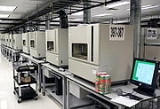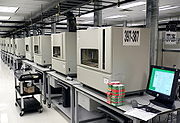
DNA sequencer
Encyclopedia

Scientific instrument
A scientific instrument can be any type of equipment, machine, apparatus or device as is specifically designed, constructed and often, through trial and error, ingeniously refined to apply utmost efficiency in the utilization of well proven physical principle, relationship or technology to...
used to automate the DNA sequencing
DNA sequencing
DNA sequencing includes several methods and technologies that are used for determining the order of the nucleotide bases—adenine, guanine, cytosine, and thymine—in a molecule of DNA....
process. It can be also considered an optical instrument
Optical instrument
An optical instrument either processes light waves to enhance an image for viewing, or analyzes light waves to determine one of a number of characteristic properties.-Image enhancement:...
as it generally analyses light signals originating from fluorochromes attached to nucleotides.
DNA sequencers have become more important due to large genomics
Genomics
Genomics is a discipline in genetics concerning the study of the genomes of organisms. The field includes intensive efforts to determine the entire DNA sequence of organisms and fine-scale genetic mapping efforts. The field also includes studies of intragenomic phenomena such as heterosis,...
projects and the need to increase productivity.
Modern automated DNA sequencing instruments (called DNA sequencers) are able to sequence multiple samples in a batch (run) and perform as many as 24 runs a day. These perform only the size separation and peak reading; the actual sequencing reaction(s), cleanup and resuspension in a suitable buffer must be performed separately.
The magnitude of the fluorescent signal is related to the number of strands of DNA that are in the reaction. If the initial amount of DNA is small, the signals will be weak. However, the properties of PCR allow one to increase the signal by increasing the number of cycles in the PCR program.
A simple DNA sequencer will have one or more lasers that emit at a wavelength that is absorbed by the fluorescent dye that has been attached to the DNA strand of interest. It will then have one or more optical detectors that can detect at the wavelength that the dye fluoresces at. The presence or absence of a strand of DNA is then detected by monitoring the output of the detector. Since shorter strands of DNA move through the gel matrix faster they are detected sooner and there is then a direct correlation between length of DNA strand and time at the detector. This relationship is then used to determine the actual DNA sequence.
The output of these machines is not perfect as it may contain reading errors and needs to be processed (see Sequence assembly
Sequence assembly
In bioinformatics, sequence assembly refers to aligning and merging fragments of a much longer DNA sequence in order to reconstruct the original sequence. This is needed as DNA sequencing technology cannot read whole genomes in one go, but rather reads small pieces of between 20 and 1000 bases,...
). Until a few years ago, this task was done manually by an operator. The assembly process for a contig made of 10 samples took about 5–15 minutes, depending on the quality of the samples. However, today, modern software can automatically process the output in seconds.
See also
- PerkinElmerPerkinElmerPerkinElmer, Inc. is an American multinational technology corporation, focused in the business areas of human and environmental health, including environmental analysis, food and consumer product safety, medical imaging, drug discovery, diagnostics, biotechnology, industrial applications, and life...
- Caliper Life SciencesCaliper Life SciencesCaliper, A PerkinElmer Company is based in Hopkinton, Massachusetts with direct sales, service and application-support operations in countries around the globe...
- Beckman CoulterBeckman CoulterBeckman Coulter Inc., is a company that makes biomedical laboratory instruments. Founded by Caltech professor Arnold O. Beckman in 1935 as National Technical Laboratories to commercialize a pH meter that he had invented, the company eventually grew to employ over 10,000 people, with $2.4 billion in...
- 454 Life Sciences454 Life Sciences454 Life Sciences, is a biotechnology company based in Branford, Connecticut. It is a subsidiary of Roche, and specializes in high-throughput DNA sequencing.-History and Major Achievements:...
- Applied BiosystemsApplied BiosystemsApplied Biosystems, Inc. started as GeneCo , was the name of a pioneer biotechnology company founded in 1981 in Foster City, California, in the San Francisco Bay Area...
- LI-COR BiosciencesLI-COR BiosciencesLI-COR Biosciences designs, manufactures, and markets instruments for biological and environmental research. It is ISO 9001 certified, meaning that it demonstrates "its ability to consistently provide products that enhance customer satisfaction and meet applicable statutory and regulatory...
- IlluminaIllumina (company)Illumina, Inc. is a company incorporated in April 1998 that develops, manufactures and markets integrated systems for the analysis of genetic variation and biological function. Using its technologies, the company provides a line of products and services that serve the sequencing, genotyping and...

